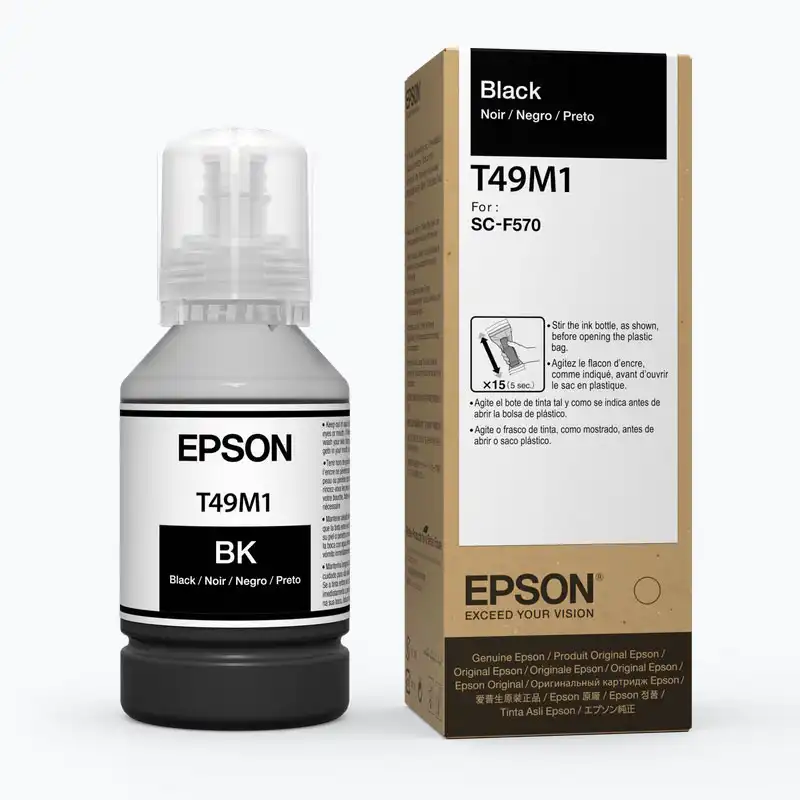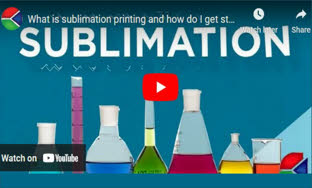What do you need to start sublimation printing?
Sublimation printing has emerged as a dynamic force in the 'print-on-demand' custom product industry, captivating consumers with a myriad of exciting, must-have items. The perceived value of these products remains exceptionally high, ensuring lucrative returns for businesses venturing into this niche.But what exactly is sublimation printing, and what does it take to dive into the vibrant world of full-color sublimated products?
What is the science behind sublimation printing?

Sublimation involves a sophisticated process known as dye-sublimation transfer, where digital images are first printed using a sublimation printer and special inks onto sublimation transfer paper. These images are then transferred onto a polyester or poly-coated item through a heat press, where the ink turns into a gas and infuses into the substrate, creating stunning and durable results.
This method is celebrated for its ability to produce vibrant, full-color images on a wide range of products—from hard goods like coffee mugs and aluminum photo panels to soft goods such as t-shirts and pillowcases. The end products are not only visually impressive but are also durable and less prone to fading, as the ink becomes a part of the substrate itself.
What exactly is a sublimation printer?

In practical terms, choosing the right sublimation printer depends heavily on your business needs. For instance, the Epson F170 is highly recommended for its portability, making it an ideal choice for businesses that set up at various events. On the other hand, the Epson F570, known as the SureColor 570, offers unmatched affordability and reliability for high-volume production settings. Each of these printers has unique attributes that cater to different aspects of the booming sublimation market.
What is sublimation paper?

Sublimation paper acts as the essential 'carrier' for sublimation ink, enabling it to be transferred onto various items. This specialized paper securely holds the ink until it is pressed onto a substrate using a heat press. The process might seem straightforward, but the choice of sublimation paper can significantly influence the quality of the final product. This is because different types of sublimation papers are engineered for different kinds of substrates, which are categorized broadly into soft and hard substrates.
It’s important to remember that using regular paper for sublimation transfers will not yield satisfactory results. Sublimation papers contain coatings that manage the ink's release and adhesion to the substrate, which regular paper lacks, making it unsuitable for achieving the high-quality outcomes expected in sublimation printing.
What is sublimation ink?

Sublimation ink is the lifeblood of the sublimation printing process, often described as the "water" of this vibrant ecosystem. This eco-friendly ink is a unique formulation of water and heat-reactive dyes, devoid of solvents or any additional chemicals, making it a greener choice for printing. Leading the market in this space is Epson, known for their commitment to sustainability and quality.
When it comes to color and vibrancy, sublimation inks from Epson are unparalleled. They deliver rich, eye-catching colors that are deeply infused into the substrate, creating durable and vivid prints. This level of quality is achieved through years of research and development, ensuring their inks perform exceptionally on a wide range of substrates.
While sublimation ink can technically be used for regular printing, it is not advisable due to its high cost and the specific color output it generates, which may not be suitable for standard document printing. Essentially, while you can use sublimation ink for regular printing tasks, its specialized nature and cost make it impractical for such uses.
What is a sublimation heat press?

A sublimation heat press is a specialized piece of equipment essential for transferring designs onto substrates through the sublimation process.
Characterized by its swing-away design, this type of heat press offers superior functionality for sublimation tasks by providing the operator with full access to the pressing table. This accessibility is crucial for placing and adjusting materials accurately under the heat platen.
For a heat press to be effective in sublimation, several key features are necessary:
- A swing-away top that allows complete access to the pressing area, facilitating easier layout and adjustment of transfer materials.
- Even pressure distribution across all four corners of the press to ensure uniform image transfer.
- Consistent heat distribution across the entire surface to prevent cold spots that could lead to incomplete transfers.
- Digital controls and timers for precise temperature and time setting, which are critical for achieving optimal results.
- Robust construction, typically from solid steel, to withstand the rigors of heavy and continuous use.
One exemplary model that checks all the boxes is the Geo Knight DK20S, a flagship 16x20 swing-away heat transfer press renowned for its reliability and performance. The DK20S operates within a temperature range of 375° to 425° F and can exert between 40-80 psi, ensuring that you achieve consistent results with every use, essential for both high-quality and high-volume production.
When choosing a heat press for sublimation, it's crucial to select a machine that not only meets the technical demands of sublimation but also one that fits the scale of your operations. Whether you’re outfitting a small boutique or a large production facility, the right heat press is a pivotal investment. The Geo Knight DK20S comes highly recommended for its comprehensive features and robustness, making it a worthwhile cornerstone for any serious sublimation business. Remember, a quality heat press is a versatile tool that can handle various other fabric decoration techniques, such as vinyl transfers and rhinestone applications, thereby enhancing its value and utility in a diverse crafting or garment production environment.
What types of products are suitable for sublimation?

What items can be transformed through sublimation? The possibilities are vast, ranging from full-color name badges and coffee mugs to metal art prints,, home decor items, and personalized keepsakes. The versatility of sublimation makes it a popular choice for creating unique and vibrant products.
At its core, sublimation ink has a natural affinity for polyester, bonding well with poly-coated materials due to its oil-loving molecular structure. This process involves a sublimation coating, a clear polyester-based material that captures the dye in an extremely tight pattern, ensuring sharp, high-resolution results. Traditionally, sublimation works best on white and light-colored materials and fabrics because there is no white sublimation ink available. This limitation means that sublimation cannot traditionally be applied to dark materials directly.
The market for blank sublimation products is currently booming, with an ever-expanding array of high-quality, trendy items becoming available. As new products continuously enter the market, tools like laser cutters enhance the potential for customization even further, allowing users to create their own bespoke sublimation blanks from a variety of pre-coated materials. Whether you are looking to expand product offerings or explore new creative avenues, sublimation provides a powerful platform to turn imaginative ideas into tangible, marketable products.
How do I price sublimation products for retail sales?

Determining the right pricing for sublimation products in the retail market is a common query among creative entrepreneurs. When you’re creating high-quality, visually appealing products, it’s crucial to ensure that your pricing not only covers your costs but also generates a profitable return.
Choosing the right products from the myriad of available blank substrates is just the first step. Once you’ve mastered a new technique or design for a chosen substrate, the next crucial step is pricing. Several key factors play into effective pricing strategy: the cost of goods sold (COGS), the time it takes to produce each item, the consumables like ink and paper, as well as packaging, shipping, and marketing expenses.
To establish a competitive and profitable pricing structure, you should start by calculating these costs to determine your baseline. This will give you a clear understanding of the minimum price you need to cover expenses and the target price to ensure profitability. For a comprehensive guide on how to maximize your return on investment (ROI) and develop a detailed pricing strategy for your sublimation products, consider exploring additional resources such as the article 'The Ultimate Guide to Retail Pricing Sublimation Products'. This resource provides an in-depth look at crafting a pricing strategy that aligns with market demands while ensuring your business's financial goals are met.
Is sublimation printing profitable?

Is sublimation printing a profitable venture? Absolutely, especially when you consider the relatively low startup costs and the potential for high returns on investment (ROI). For instance, if you already own a heat press, an initial investment of approximately $450 could set you up with a sublimation printer, the necessary inks, and paper, enabling you to start producing items by the end of the day. The ongoing cost of inks is modest, typically around one penny per square inch of the printed transfer, with an added equivalent cost for paper.
To better understand the potential profitability, let's consider some practical examples. An 11oz ceramic coffee mug, for instance, can be produced for around $2.00 when you add a customer’s logo or image. This mug can then retail for between $16.00 and $20.00, depending on your market. Introducing premium licensed art images can further increase the retail price. Another example is a name badge, which costs about $1.25 to produce and can retail for between $8.00 and $12.00. These examples highlight the significant markup potential and the profitability of sublimation printing.
Incorporating sublimation printing into your business is not just about immediate gains but also about building a sustainable, scalable model. This printing method is not only eco-friendly but also highly in demand due to its ability to produce vibrant, high-quality products that consumers value highly. As you expand your range of products and refine your skills, your business can grow significantly, both in product offerings and profitability. Sublimation printing offers a lucrative opportunity for those willing to invest in the necessary equipment and develop their craft.



































